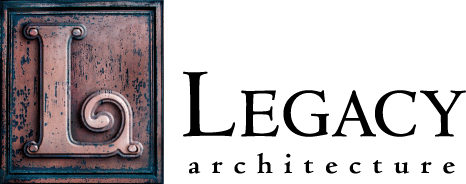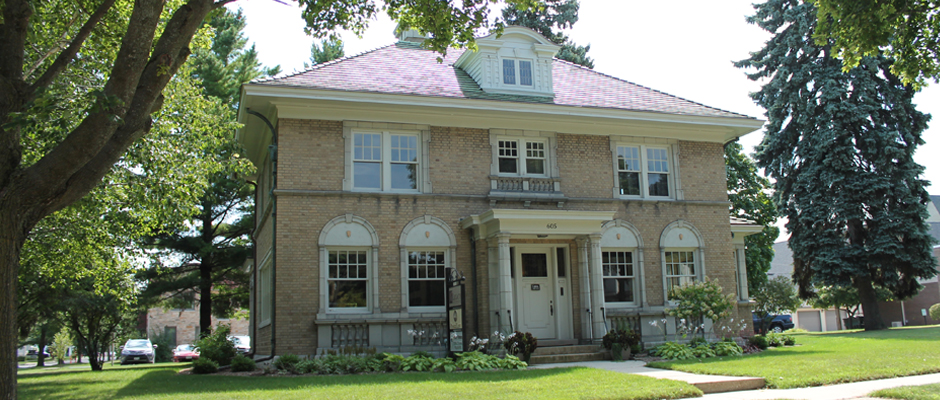Improvements Bring 1923 Prange Mansion Up to Date
Schultz, Deanne. The Sheboygan Press, January 24, 2015, page A1.
Christmases were a special time for Jerry and Kay Groth when their family lived at 605 Erie Ave. in Sheboygan. They decorated the house for the holidays, placing a lit candle in each of the home's 39 windows.
"It was quite a beautiful scene," Groth recalled.
Groth served as the pastor of St. Mark's Lutheran Church, which owned 605, using it as a parsonage from 1947 to 1998, when the house was closed up.
The stately Mediterranean house, almost 75 years old when the Groths lived there, exuded elegance, but showed its wrinkles. The windows leaked and in winter "it could get a little drafty, especially when the wind blew off the lake, but not bad," Jerry said.
The church lacked funds necessary to modernize the house, spending between $5,000 and $6,000 annually to heat the home enough to prevent freezing pipes.
But thanks to Jennifer Lehrke, owner of Legacy Architecture, the grand dame is getting a facelift, including some critical energy-efficient measures.
Nyhof Custom Gutter & Aluminum of Oostburg blew recycled cellulose Champion Insulation in the walls, and the 2-by-6 studs provided space for extra insulation.
Legacy Architecture will use the 91-year-old house for its offices.
Extra insulation
"We were able to put in more insulation than new houses have," Lehrke said, showing a handful of the fluffy grey insulation, made from recycled newsprint.
According to Champion's web site, almost 67 percent of all heat loss occurs in the ceilings and walls of a building.
Dave Halkin, insulation salesman and scheduler at Nyhof, said that in the sunroom ceiling and attic, 31/2 inches of BASF polyurethane expandable closed-cell foam was laid down, completely sealing the space. Topping that was a layer of dense-packed Champion Insulation.
Halkin said the result is an R-value of 50 in the ceiling, and 21 in the walls.
Lehrke has noticed other benefits, too - the rooms grew warmer "almost instantly," and street noises diminished greatly.
Also receiving an update are the toilets. The home featured old-fashioned, three-gallon flush models dating to the 1940s. They'll be replaced with new Kohler 1.28-gallon flush models.
They're one of Kohler's WaterSense products, certified to be at least 20 percent more efficient without sacrificing performance.
Water efficiency advancements
Because 605 stood empty for 16 years, it missed what Rob Zimmerman, senior channel manager-sustainability for Kohler Co., called "the rapid and significant advancements in water efficiency."
He said the Environmental Protection Agency's WaterSense labeling program started in 2006, with the first wave of WaterSense toilets coming to market a year later, followed by faucets and showerheads. All these models must pass stringent performance tests to earn the WaterSense label.
Lehrke's upgrades continued with air conditioning, but she didn't want to mar the home's beautiful historic details with cumbersome ductwork and large grates. The solution was a Unico System, installed by Lakeshore HVAC & Solar Co., which has one-third the surface area of conventional ducting.
"It uses 3-inch diameter pipe to deliver the air conditioning, which fits right in the wall," Lehrke said. "They also don't use big vents or grills."
On the first floor, a grill custom-made from the same wood as the floor, was an unassuming reminder of the system's presence.
Lehrke also said that the Unico System is perfect for restoration projects, thanks to flexible small ducts that can be routed through existing ceiling, floor and wall cavities.
"Because it uses a tube, it's completely sealed, which increases efficiency," she said.
It's important to maintain as many of the home's original characteristics as possible. Several of the original light fixtures and sconces were still intact; they'll be removed, cleaned, and re-installed, their incandescent bulbs swapped with 85 energy-efficient LED light bulbs.
Lehrke said LED bulbs "use 10 percent of the energy consumption (of incandescent bulbs). We'll cut 90 percent (of our energy costs) right there."
Not all things change
She worked with Arch Electric of Plymouth, a Trade Ally of Focus on Energy. Through Focus's Small Business Program, Arch performed a free lighting assessment to identify opportunities for energy efficiency.
All appliances, computers and televisions in the home also are Energy Star certified.
But there are some things that are staying put, with no modern adaptations.
Eliza Prange, who built the home in 1923, maintained a staff of servants, whom she summoned by means of a switch in her room. In the dining room, Eliza could discreetly alert the butler to her needs by pressing a disc-shaped toe buzzer under the table. Lehrke has no plans of removing either.
"I was upstairs one day, flipping the switch in Eliza's room, when my mom called out from downstairs, saying the lights were flashing," Lehrke said. "That's when we discovered the servant call system."
And it's the nod to the bygone era that Lehrke wants to maintain during this process, saying "in the end, you get a valuable product. It's unique, because it was custom made."

